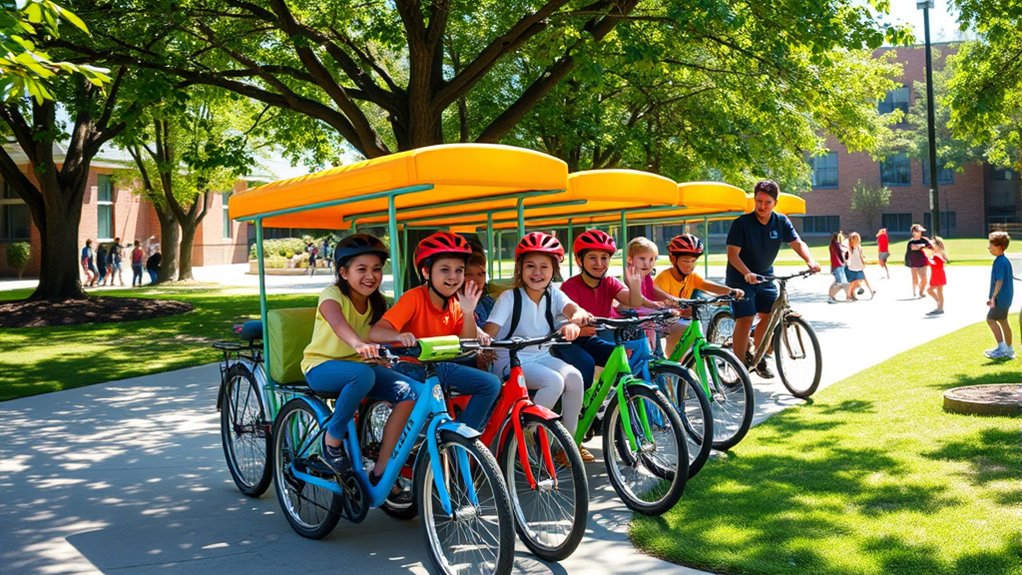Bike buses offer a safe, eco-friendly way for you and your students to travel together. Supervised by responsible adults, these group cycling routes boost safety, teach road safety, and promote a healthy lifestyle. They also help reduce traffic around schools, easing congestion and pollution. By choosing bike buses, you can build community while supporting environmental responsibility. Curious about how to implement this? Keep exploring to discover more about creating safer, greener school trips.
Key Takeaways
- Group cycling with adult supervision ensures safer transportation for students during school trips.
- Designated routes and adult oversight minimize risks like children getting lost or straying.
- Bike buses promote safety awareness and proper cycling habits among students through hands-on experience.
- Riding in groups enhances visibility and safety compared to individual biking or walking.
- Implementing bike buses reduces traffic congestion and associated safety hazards around schools.

Have you ever wondered how to make school trips safer and more eco-friendly? One innovative solution gaining popularity is the concept of bike buses. A bike bus functions much like a traditional school bus, but instead of a vehicle, a group of students bikes together along a designated route, supervised by adults. This approach promotes eco friendly commuting, reduces traffic congestion, and encourages a healthy lifestyle among students. By choosing bike buses, you can markedly cut down on the number of cars on the road during school hours, easing traffic congestion around schools and making the commute safer for everyone.
Using bike buses encourages children to ride in groups, which enhances safety during the trip. When kids travel together in a coordinated, supervised manner, they’re less likely to stray into dangerous areas or get lost. Plus, having adults oversee the route ensures that any unforeseen issues are quickly addressed, creating a secure environment for students. This setup not only reduces the risk of accidents but also fosters a sense of community and teamwork among students. They learn the importance of road safety, proper cycling habits, and respecting traffic rules through hands-on experience.
Group cycling with adult supervision enhances safety and builds community among students.
In addition to safety benefits, bike buses support environmental sustainability. Since bikes produce zero emissions, switching from cars to bike buses drastically lowers the carbon footprint associated with school trips. This visible commitment to eco friendly commuting can inspire students and families to adopt greener transportation habits beyond just school hours. It’s a simple yet effective way to teach the next generation about environmental responsibility while actively contributing to cleaner air and reduced noise pollution in your community. Moreover, choosing appropriate projector technology can enhance the educational experience during presentations and outdoor lessons, making learning more engaging and effective.
Implementing bike buses also alleviates traffic congestion around school zones. During peak hours, the influx of cars can lead to stressful jams, delays, and increased pollution. By organizing bike buses, you reduce the number of individual car trips, easing the burden on local roads. This not only benefits the environment but also makes mornings and afternoons less hectic for parents, teachers, and students. With fewer vehicles clogging the streets, everyone can arrive and depart more smoothly, fostering a more relaxed and efficient school day.
Frequently Asked Questions
How Are Bike Buses Funded and Maintained?
Bike bus funding often comes from local government grants, school budgets, or community sponsorships, ensuring you have the resources needed. Maintenance for bike buses is typically handled by trained staff or volunteers who perform regular safety checks and repairs. You might also see partnerships with local bike shops or organizations that help with bike bus maintenance, keeping the fleet safe and reliable for your school trips.
What Training Do Staff Receive for Safety Management?
Like a seasoned knight preparing for battle, your staff receives thorough safety management training. They learn emergency protocols to handle unexpected situations confidently. Staff certification ensures they meet safety standards, covering bike handling, traffic rules, and communication skills. Ongoing training keeps everyone updated on best practices. This preparation helps keep students safe during trips, so you can focus on fun and learning, knowing your team is ready for any challenge.
Are Bike Buses Suitable for All Weather Conditions?
Bike buses aren’t suitable for all weather conditions. When it rains, you’ll need rain gear to stay dry and comfortable, and weather shelters can provide some protection during stops. However, in extreme weather like storms or icy conditions, it’s safer to avoid bike buses altogether. Planning ahead and checking the weather forecast helps guarantee safety, so you can decide whether to proceed or postpone the trip.
How Do Bike Buses Coordinate With Individual Student Schedules?
Think of bike buses as a well-oiled machine working in harmony with your schedule. You coordinate route scheduling by setting specific pick-up points and times that match student participation. This way, everyone’s needs are met, and the process runs smoothly. You stay flexible, adjusting routes as needed, ensuring students can join the bike bus without missing their other commitments. It’s all about creating a seamless, teamwork-driven system.
What Measures Ensure Student Behavior Is Monitored During Trips?
You guarantee student behavior is monitored during trips by implementing strict supervision protocols, including designated adult supervisors at key points. You also use behavioral incentives to encourage positive conduct, such as rewards for good behavior. By maintaining constant oversight and motivating students to follow safety rules, you create a secure environment. These measures help prevent issues and promote responsible behavior throughout the trip, making it safer and more organized for everyone involved.
Conclusion
Imagine a bike bus as a river of children, flowing smoothly and safely toward school. Just like a well-guarded convoy, it reduces accidents and encourages healthier habits. When I saw a bike bus in action, I realized it’s more than transportation — it’s a movement towards safer, greener mornings. Studies show bike buses can cut traffic congestion and emissions, making each ride a small but powerful step toward a better community. Together, we can keep that river flowing safely.
















